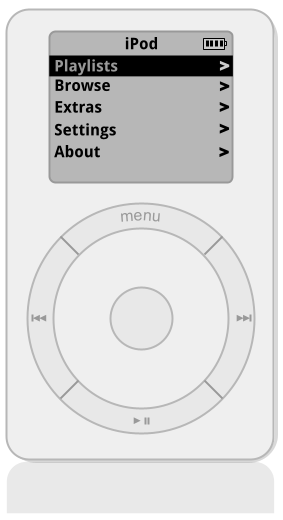The Story
When Apple unveiled its iPod digital music player back in October 2001, I dismissed it as a parity product. I already owned the Cowon iAUDIO CW100 MP3 player, loaded with my favorite tunes. There was Apple, generating great hype over the iPod as if it were a breakthrough product.
The idea of a portable digital music player was nothing new. The first mass-produced MP3 players came out in 1998. In late 2001, the concept may have been new to a lot of Apple customers, but it wasn't new to me. I proudly showed my MP3 player to friends when they gushed about the iPod.
 Thus Apple's iPod was not an innovative product in and of itself. Years later, however, I realized the significance of ecosystem of which the iPod was a part. Apple had released iTunes (with technology purchased from SoundJam MP) and created the iTunes Store for finding and downloading music. Unlike Napster, it was a safe and legal way of distributing and acquiring music.
Thus Apple's iPod was not an innovative product in and of itself. Years later, however, I realized the significance of ecosystem of which the iPod was a part. Apple had released iTunes (with technology purchased from SoundJam MP) and created the iTunes Store for finding and downloading music. Unlike Napster, it was a safe and legal way of distributing and acquiring music.
The prior way of playing portable digital music required a user first:
Apple had created an ecosystem. Its product managers and designers considered the entire set of user experiences, not just users' direct experiences with digital music players. If you viewed the iPod as a product in isolation, it wasn't innovative. The innovation was in creating a set of elegant (and legal) user experiences around acquiring and playing digital music.
The Lesson
This story makes you wonder: what is a product? Is a product a collection of features? Or is a product, in a sense, a set of user experiences? Product managers should focus on enabling users to have a set of experiences. Doing so requires considering (and building, if necessary) the entire ecosystem, not just a piece of it. The real innovations often lie outside of what product managers typically consider to be the product.
When Apple unveiled its iPod digital music player back in October 2001, I dismissed it as a parity product. I already owned the Cowon iAUDIO CW100 MP3 player, loaded with my favorite tunes. There was Apple, generating great hype over the iPod as if it were a breakthrough product.
The idea of a portable digital music player was nothing new. The first mass-produced MP3 players came out in 1998. In late 2001, the concept may have been new to a lot of Apple customers, but it wasn't new to me. I proudly showed my MP3 player to friends when they gushed about the iPod.
The prior way of playing portable digital music required a user first:
- "Rip" a song from CD or download the MP3 file (illegally, in many cases) from Napster.
- Connect a USB or other cable and transfer the file to a portable MP3 player (after installing the appropriate drivers).
No big deal for me. But the vast majority of users didn't know how, or want, to mess around with ripping CDs, installing drivers, or downloading and transferring files. They wanted to acquire and listen to songs, not files. Before Apple's iTunes and iPod, it was about "ripping", drivers, files, and transfers.
Apple had created an ecosystem. Its product managers and designers considered the entire set of user experiences, not just users' direct experiences with digital music players. If you viewed the iPod as a product in isolation, it wasn't innovative. The innovation was in creating a set of elegant (and legal) user experiences around acquiring and playing digital music.
The Lesson
This story makes you wonder: what is a product? Is a product a collection of features? Or is a product, in a sense, a set of user experiences? Product managers should focus on enabling users to have a set of experiences. Doing so requires considering (and building, if necessary) the entire ecosystem, not just a piece of it. The real innovations often lie outside of what product managers typically consider to be the product.
Comments
I had the great fortune to have Ted Levitt as my advisor on on a cool project while attending Harvard Business School. He taught me to think about the COMPLETE PRODUCT as the collection of tangle and intangible expectations of customers that we plan to meet. Price structure, warranty, ease of use, available support, brand comfort... These are all part of the complete product.
Anything that can frustrate or delight a customer As they acquire, use and dispose of your product is part of your complete product. Product managers who focus on features without considering these other factors are just engineers with a bit more power.
Yes, the set of experiences constitute a product, and the experiences occur within a larger ecosystem beyond direct usage of the offering. Surprise, delight, frustration, and any other emotions that users feel during their experience are critical.